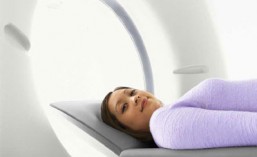PET scans, Positron Emission Tomography scans, are a type of nuclear medicine imaging. It is a medical imaging system which helps doctors detect illnesses in patients. Its purpose is to show the functioning and structures of tissues and organs. In the medical field, these scans are used to provide information on the shape and size of the parts of the body and can determine flow of blood, the usage of oxygen and sugar/glucose metabolism. A PET scan is very useful when related to sugar metabolism because it can show it before it is physically visible. PET scans are mostly used to detect cancer in tissues or to examine the effects of cancer treatments. It is also used to detect heart disease such as coronary artery disease and brain illnesses such as Alzheimer’s disease and epilepsy. All information shown by the PET scan can be used to diagnose illnesses and to make decisions about treatment. The advantage of PET scanning is that it may show more wide-ranging diseases than CT (computed tomography) or MRI (magnetic reasoning imaging) scans. This type of scan can also be combined with a CT scan to produce one, single image. When it is fused with a CT scan, it gives more precise data about the body.
(BY: Chinthuri Selvarajah)



